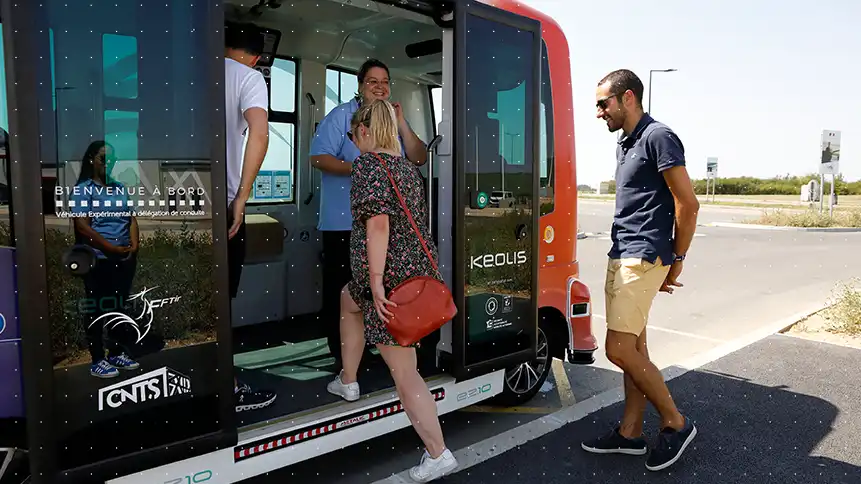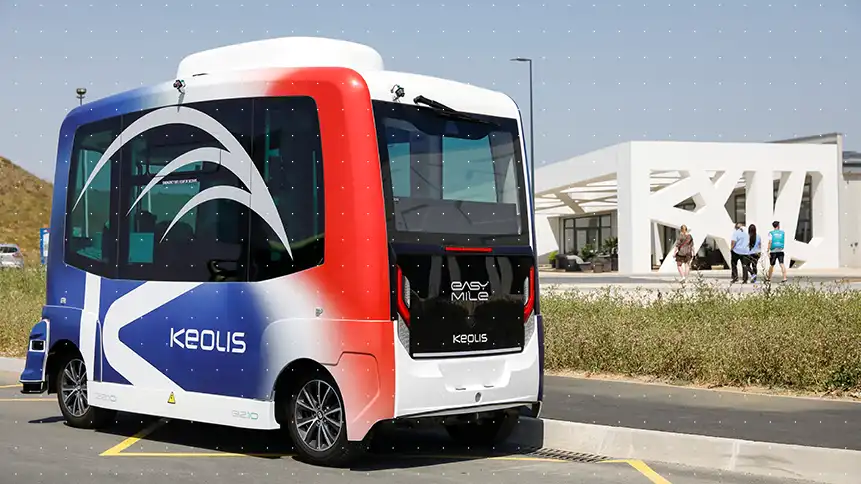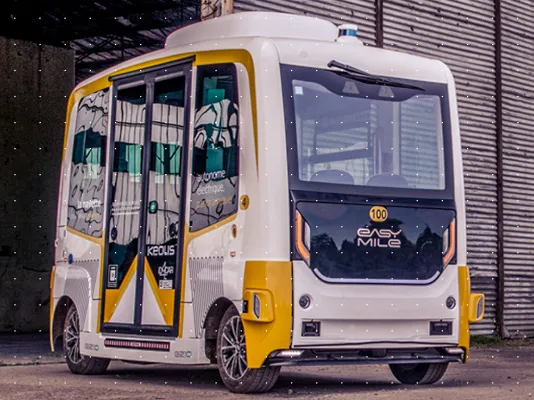In response to accelerating urban growth and increasing travelling requirements, Keolis operates innovative, high-performance and environmentally friendly autonomous mobility solutions. Deployed by Keolis in France and around the world, autonomous vehicles provide passengers and public transport authorities with an efficient, safe and appropriate response to present and future mobility needs.
Autonomous vehicles: a pertinent solution to current mobility issues
Keolis, a pioneer in autonomous mobility – since 2016
As a global leader in shared mobility and multi-modality, Keolis has been trialling autonomous shuttles and vehicles open to the general public since 2016. With these deployments in France, the United States, Australia, Canada, Belgium, the United Kingdom and Sweden, the Group has fostered a reputation as an expert in the operation of autonomous vehicles for passenger transport. Whether small-capacity shuttles or buses, autonomous vehicles travel without a driver on pre-determined routes, in dedicated or shared lanes. Whereas up to now a safety operator has been on board the vehicle, Keolis' ambition is to develop 100% autonomous driving without an operator in attendance (Grade of autonomy 4, often referred to as "No Op").
Developing shared mobility with autonomous options
Built into existing transport networks, self-driving vehicles offer an effective solution to the mobility challenges facing every community, whether urban or suburban. These services are arranged and adjusted through continuous dialogue with public transport authorities, and offer a way of providing transport to less densely occupied areas, or to complete the first and last mile of a journey. They are particularly well suited to trips in urban settings, in airports, on university campuses, on business parks, in hospitals or at tourist destinations.
Key Figures
- 195,000kilometres
- 40,000hours of operation
- 57deployments in 7 countries
- ~230,000passengers carried
Our presence in the world
Safety: the number 1 priority in autonomous transport
Autonomous vehicles travelling in total safety
With eight years of operating autonomous mobility services and trials around the world, Keolis has developed comprehensive expertise in the entire lifecycle of autonomous bus and shuttle projects.
The Group guarantees safe journeys and keeps passengers informed. The vehicles combine several navigation and control systems, configured according to the characteristics of the journey: cameras to analyse obstacles, laser remote sensing (LIDAR) to represent the environment in 3D, satellite GPS navigation system, motion sensors, emergency stop button, intercom for communication with the supervisor, secure communication with the connected infrastructure, etc. Depending on the level of autonomy of the vehicle, a safety operator is constantly present: either on board the vehicle (grade of autonomy 3) to be able to resume driving in manual mode if necessary, or remotely (grade of autonomy 4) from a control station enabling them to regulate and supervise the vehicle at all times, and communicate with the passengers.
Remotely supervising autonomous buses with 5G
Keolis is studying new solutions such as the use of 5G to further improve the safety of autonomous vehicles. This technology enables video supervision or remote assistance in real time, with a level of safety and reliability that cannot be matched by 4G.
This innovation was tested in Sweden in 2022, in partnership with Ericsson and Telia, as part of a pilot project on the island of Djurgården with an autonomous electric SUV. 5G connectivity made it possible to validate a request to overtake that had been issued automatically by the vehicle - a first in terms of remote assistance.
Offering a premier user experience
The Keolis Group takes a close interest in the quality of the user experience and the impact of unattended vehicles on the acceptability of travel in an autonomous vehicle. For example, studies have helped improve customer care and provide more relevant passenger information on board the autonomous shuttles currently in use at the Autonomous Mobility Test Site (SEMA) in Châteauroux.

The road to 100% autonomous mobility: the Autonomous Mobility Test Site (SEMA)
Remote supervision, passenger communication, handling automatic alerts and troubleshooting: since 2019, Keolis has been trying out the technologies at the heart of 100% autonomous mobility at the Autonomous Mobility Test Site, located in Châteauroux (36). This private, closed and secure 80-hectare site is the only one of its kind in the world, giving Keolis the opportunity to drive in real-life conditions and build the capabilities it needs to prepare and refine its plans for full autonomy.
SEMA is housed on the site of the National Shooting Sports Centre, where the French Olympic and Paralympic teams train, and which also hosts several national and international competitions. As part of these events, Keolis uses its two Grade of Autonomy 4 shuttles to provide pinpointed services to the various shooting stands.
Becoming one of the leading French operators to run no-op autonomous public transport services is one of Keolis’ goals. With its partner EasyMile, the Group has already accomplished the feat of operating Grade of Autonomy 4 private services at SEMA. And it has no intention of stopping there, since it is now involved in the Mach 3 project aiming to operate an autonomous bus route in Châteauroux city centre, starting in 2026. This new automated service comprising several electric minibuses will slot seamlessly into Châteauroux Métropole’s public transport network.
Autonomous, all-electric and sustainable shuttles
With the development of autonomous mobility, Keolis asserts its commitment to green mobility in the community, alongside public transport authorities. As an alternative to individual vehicles on short journeys, using autonomous vehicles contributes to reducing greenhouse gas emissions. Furthermore, when operating in on-demand mode, autonomous vehicles only fulfil a specific request for mobility, which limits unladen mileage and optimises journeys by grouping trips together. Electric shuttles epitomise the future of public transport, in a reinvented city that is calmer, less congested and more sustainable.

Building autonomous mobility into existing transport networks
Since the world's very first autonomous shuttle trial in Lyon's Confluence district in 2016, Keolis has deployed over 55 publicly accessible autonomous mobility services in association with public transport authorities. With shuttles launched in Rennes and Lyon (France) and Newcastle (Australia) and the presentation of an autonomous bus in Gothenburg (Sweden), the Group is now seen as an expert in the operation and supervision of fleets of autonomous vehicles. Autonomous vehicles can be integrated into existing transport networks, encouraging shared mobility. Multimodality can be facilitated by adapting passenger information and introducing combined fare structures.
Among our references
A regular autonomous shuttle service in the Yvelines
After winning France's first ever tender for a regular autonomous shuttle service, Keolis operated three autonomous shuttles running between the Saint-Quentin-en-Yvelines / Montigny-le-Bretonneux railway station and a business park, under a concession contract that lasted from March 2021 to June 2022. The vehicles blended into car traffic along a 1.6-km stretch of road and were included in the route planner of the Île-de-France Mobilités app, just like the other 1,500 bus routes in the Île-de-France network.
